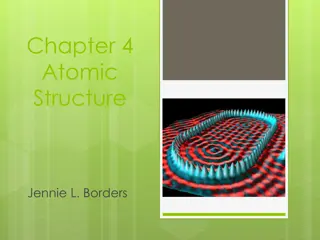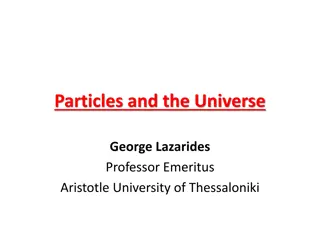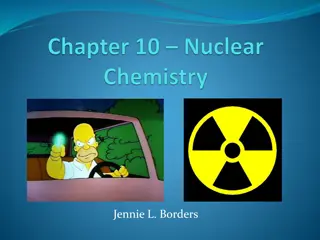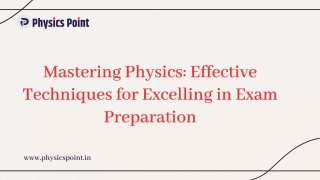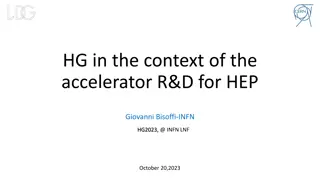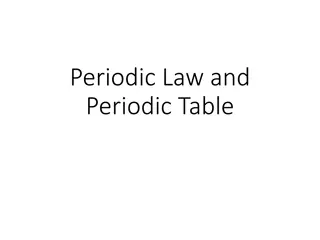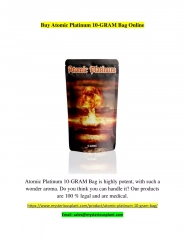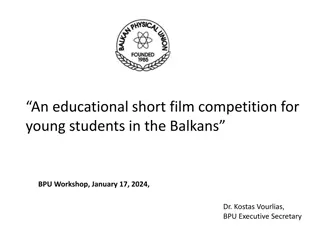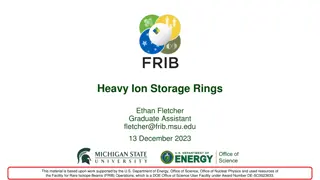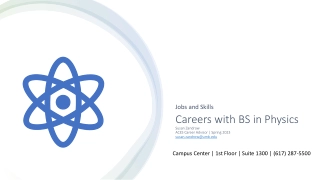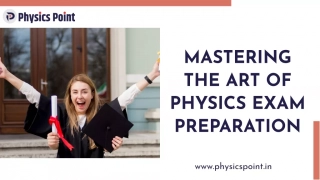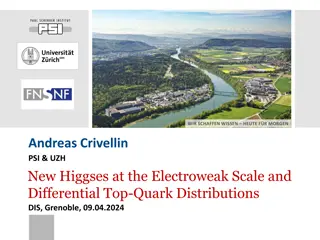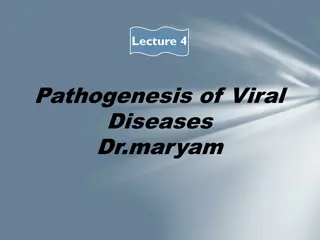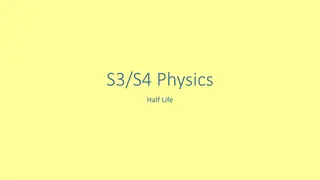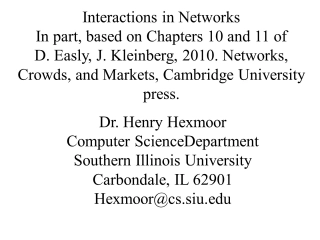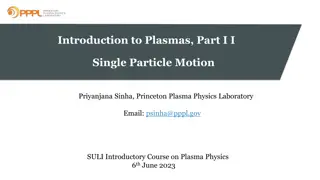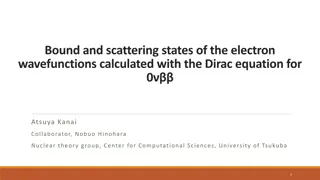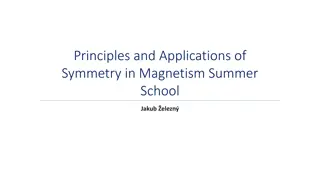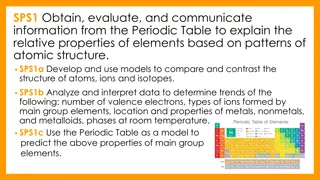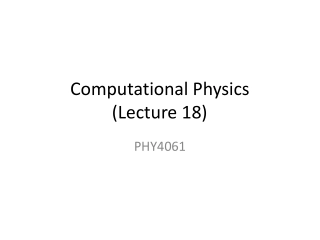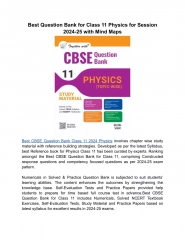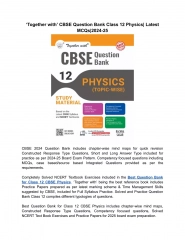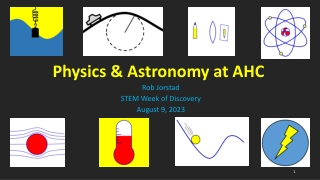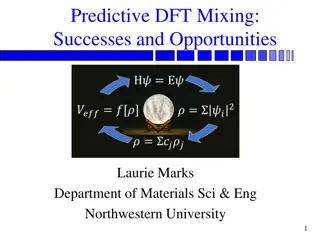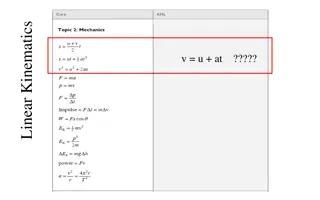Understanding Hyperfine Interactions in Atomic Physics
Hyperfine interactions play a crucial role in atomic physics, leading to small energy shifts and splitting of degenerate levels in atoms and molecules. These interactions involve the electromagnetic multipole interactions between the nucleus and electron clouds, resulting in the splitting of energy levels due to the interaction of nuclear magnetic and electric moments with external fields. Hyperfine structure impacts both atomic nuclei and electronic levels, removing degeneracy and causing discrete energy values. This overview covers the Nuclear Zeeman effect, interactions of magnetic moments, and the Electric quadrupole in an electrostatic field.
Understanding Hyperfine Interactions in Atomic Physics
PowerPoint presentation about 'Understanding Hyperfine Interactions in Atomic Physics'. This presentation describes the topic on Hyperfine interactions play a crucial role in atomic physics, leading to small energy shifts and splitting of degenerate levels in atoms and molecules. These interactions involve the electromagnetic multipole interactions between the nucleus and electron clouds, resulting in the splitting of energy levels due to the interaction of nuclear magnetic and electric moments with external fields. Hyperfine structure impacts both atomic nuclei and electronic levels, removing degeneracy and causing discrete energy values. This overview covers the Nuclear Zeeman effect, interactions of magnetic moments, and the Electric quadrupole in an electrostatic field.. Download this presentation absolutely free.
Presentation Transcript
Nuclear probes in materials - M ssbauer effect and M ssbauer spectroscopy
External EM field - energy Energy of a stationary charges and currents in external EM field Charge; Electrostatic potential Electric dipole moment (= 0); Intensity of electric field Intensity of magnetic field Magnetic dipole moment; Tensor of electric field gradient Electric quadrupole moment; Odd electric moments = 0 = Even magnetic moments (p conservation law) Higher orders can be neglected E shifts weaker by a few orders of magnitude. In atoms/nuclei, hyperfine structure occurs due to the energy of the nuclear magnetic dipole moment in the magnetic field generated by the electrons, and the energy of the nuclear electric quadrupole moment in the electric field gradient due to the distribution of charge within the atom/nuclei.
Hyper-fine interactions (in atomic physics) hyperfine structure is a small shift in otherwise degenerate energy levels and the resulting splitting in those levels of atoms (molecules) due to electromagnetic multipole interaction between the nucleus and electron clouds In atoms, HF structure arises from the energy of the nuclear m interacting with B generated by the e- and the energy of the nuclear quadrupole moment in the EFG due to the distribution of charge within the atom. The influence of magnetic moments leads to splitting (removing degeneracy) of levels in the nucleus as well as for electronic levels. In this course - hyperfine interaction dominantly deals only with splitting of levels in the nucleus Schematic illustration of fine and hyperfine structure in a neutral hydrogen atom electronic levels Fine splitting is only due to interaction of e- However, HF interaction impacts also (splitting of) levels of atomic nuclei
Nuclear Zeeman effect Interaction of magnetic dipole moment with magnetic field: Bis a sum of contribution of external + surrounding e- Energy of a magnetic dipole is then given by Projection m can reach only discrete values: m = -I, -I+1, , I-1, I (in units of h) Actual energies are discrete m complete multiplet splitting hyper-fine interaction (can cause shift in E) 57Fe E DE Ip (shifted due to HI) + split multiplet of states (2I +1) x degenerated level 0 Allowed only transitions with DmI= -1,0,1
Electric quadrupole in electrostatic field: Interaction of quadrupole moment with the electric field gradient (at nucleus) Cartesian coordinate system Spherical coordinate system After diagonalization in Cartesian CS (Vxy,... = 0) If axial symmetry: = 0: } asymmetry Only axial symmetry systems discussed below
axial symetry = 0: Electric quadrupole v electrostat. field: nuclear Stark effect Only partial multiplet splitting 57Fe eQ is electric quadrupole moment (multipole moment is in general defined as zeroth moment component for maximum projection m = I ): } for a nucleus with I = 0, the quadrupole moment cannot be determined does not exist only nuclear states with I>1/2 show a splitting
Electric quadrupole in electrostatic field For cubic crystals, which are equivalent in all directions x, y and z (therefore Vzz = Vyy = Vxx) and also for axially symmetric crystals, which are equivalent in x and y (therefore Vyy = Vxx) the asymmetry parameter vanishes as = 0. In cases of smaller symmetry takes values between zero and one. For axially symmetric electric field gradients the energy of the sublevels takes the values The energy difference between two sublevels m and m is given by After introducing the quadrupole frequency for the energy difference can be written Dominant application to 57Fe only two different values of m2
Electric quadrupole in electrostatic field In contrast to the magnetic interaction the splitting of the sublevels of the nuclear state through the electric quadrupole interaction depends on the angular moment I of the sublevel and is therefore non-equidistant. The transitions frequencies n between the different sublevels are, in case of = 0, integer multiples of the smallest frequency 0. It can be written whereas 0= 3 Qfor integer nuclear spin I and 0= 6 Q for half integer nuclear spin I. As for the magnetic dipole interaction, also the electric quadrupole interaction induces a precession of the angular correlation in time and this modulates the quadrupole interaction frequency. This frequency is an overlapping of the different transition frequencies n. The relative amplitudes of the different components depend on the orientation of the electric field gradient relative to the detectors (symmetry axis) and on the asymmetry parameter .
Mssbauer effect Finite temperature impact Nuclear resonance fluorescence does not happen difference to e- transitions emission absorption M ... Nucleus mass Doppler broadening is often not sufficient to cause significant resonance absorption (for low Eg) Natural line width (t 100 ns G = 10-8eV)
Mssbauer effect Recoil compensation (how can be compensated) Doppler broadening Mechanical movement (Doppler) absorber emiter e.g. for 411 keV transition in198Hg v = 6.7 x 102m/s Use of a cascade of g transitions or nuclear reaction Angle a could be chosen to fulfill the resonance condition for the 2nd photon 1958 M ssbauer (NC 1961) nucleus bound in the crystal lattice and there is no recoil of a single nucleus momentum is transformed to the phonons (lattice vibrations), or in a fraction of emissions to the whole crystal (mass is higher by ~1023 compared to a single nucleus)
Mssbauer effect 3 different cases: B atom binding energy in a crystal emission as from a free atom (typically for Eg 1 MeV) Debay (Einstein) frequency D ( E) Energy is transformed to phonons for lower photon energies (typically for Eg hundreds of keV) recoilless emission in a fraction of cases (typically for Eg 10-100 keV) - resonance absorption happens Recoil-free fraction f In the first approximation in a model with a single phonon energy recoil is absorbed by whole crystal almost all energy is carried by the photon (crystal carries a negligible energy << linewidth) M ssbauer effect = (almost) recoil-free emission and/or absorption of g rays
Recoil-free fraction Illustration even within a classical approach: oscillating nucleus (only an illustration) Frequency seen by an observer (Doppler effect): The wave seen by an observer: - + Bessel functions Identity: Probability of recoil-free emission is:
for harmonic oscillator Recoil-free fraction Probability of recoil-free emission is: J0for a small argument In a general case (finite T) the probability is where W (~Debye-Waller or Lamb-Mossbauer factor) in Debye model of a crystal (f decreases with T) QD a measure of the strength of the bonds between the M ssbauer atom and the lattice Specifically, for T = 0 To calculate one needs adequate model of a crystal e.g. Debye model - model of phonon gas with frequencies Corresponds to (above-given)
Debye model, Einstein model Debye model is a method for estimating the phonon contribution to the heat capacity in a solid. It is a solid-state equivalent of Planck's law of black body radiation, where one treats electromagnetic radiation as a gas of photons in a box. Debye treats the vibrations of the atomic lattice (heat) as phonons in a box (the box being the solid). Debye temperature is the temperature of a crystal's highest normal mode of vibration, i.e., the highest temperature that can be achieved due to a single normal vibration. (QD ( -Fe) = 464 K) Einstein model treats the solid as many individual, non-interacting quantum harmonic oscillators. It is based on three assumptions: Each atom in the lattice is a 3D quantum harmonic oscillator Atoms do not interact with each another Atoms vibrate with same frequency (contrast with Debye model) While the first assumption is quite accurate, the second is not. If atoms did not interact with one another, sound waves would not propagate through solids. Heat capacity (Debye gives correct behavior at low T)
Line shape Breit-Wigner shape Line shape for emission detector Line shape for absorption s source absorber Observed shape in absorption experiment For a thin absorber and if then Theoretical line-shape known very small change of Egcan be measured (on a fraction of G) energy resolution (depending on isotope) is The best tool to study hyperfine interaction (change of energies of levels due to nucleus- electron interaction)
Mssbauer effect detector Typical experimental setup: source absorber Energies of levels in absorber are checked/scanned Can be shifted or split Energy of source photon must be varied usually via Doppler effect (source is moving) usually a periodic change In 57Fe 1mm/s 4.8x10-8 eV (n =11.6 MHz, E = hn) Source (57Co) must be in a material (crystal lattice) with a high QD necessary condition for recoilless emission Lattice must be cubic non-magnetic metal (Rh, Cr, Pt, Pd, Cu) to have no splitting (commercial sources have f 0.75) Absorber must not be neither very thick to allow pass some radiation, nor very thin to see an effect If a thin absorber cannot be prepared, a "scattering" (instead transmission) arrangement might be used
How to exploit Mssbauer effect? Study of hyperfine interaction (i.e. interaction between nucleus and electrons) that manifests itself due to shift and/or split of levels in the nucleus Mossbauer spectroscopy Splitting of individual levels allows measurement/appears due to Magnetic field at the nucleus Gradient of electric field at nucleus The ground and first excited states of 57Fe split in a magnetic field. Isomer shift and quadrupole splitting of the nuclear levels in electric field gradient.
Mssbauer effect Energy difference due to splitting is on the order 10-7 eV (for B used in NMR, a few Tesla) actual fields in materials could be stronger - internal magnetic field of the metallic iron is about 33 T, the splitting is slightly higher Similar (could be much smaller or comparable in size) splitting observed due to electric field gradient (EFG) Recoil energy of a single nucleus is about 10-3 eV, i.e. much higher no chance to observe transitions via standard recoil The M ssbauer effect cannot be observed for freely moving atoms or molecules, i.e. in gaseous or liquid state
Mssbauer spectroscopy Nuclei of absorber re-emit photon (iso-tropically) after 10-7 s If high (e-) conversion coefficient (a, depends on Eg), re-emission strongly suppressed In the absorption measurement (narrow beam detected) can usually be fully neglected Measurement of conversion electrons possible (CEMS) only sensitive to sample surface (hundred(s) of nm) as low-energy e- are strongly absorbed Requirements for suitable isotope for M ssbauer spectroscopy Low Eg (10-150 keV) between 1st excited and stable GS minimization of ER The highest possible nucleus mass minimization of ER t 10-7-10-9 s (longer too narrow line, difficult to observe; shorter wide resonance with a low resolution) Stable isotope must be produced in a decay with relatively long lifetime (>1y) Electric quadrupole and magnetic dipole moment of involved levels 0 (for applications) High qD for wide range of T Fe: qD=470 K, ED=0.04 eV
Mssbauer spectroscopy Observed in about 80 isotopes (50 elements), 20 elements really used The best nucleus :57Fe, Eg= 14.4 keV ER= 1.95x10-3eV, G = 0.45x10-8eV, 2G = 0.194 mm/s high a allows to exploit even conversion e- (conversion electron Mossbauer spectroscopy) Can be used for T significantly above room T Energy resolution 3x10-13 10% 90% a = 8.56 57Co preparation using cyclotrons 56Fe(p,g) The 2nd most popular nucleus: 119Sn - 2G=0.626 mm/s (worse resolution), for chemistry The lightest izotope: 40K difficult to get (no accessible decay) The best resolution: 67Zn, (Eg= 93.26 keV, t = 9.4 ms, 2G = 3.12x10-4mm/s) problem: vibrations disturb observability Further127,129I, 125Te for chemistry 151,153Eu, 161Dy, 6 Gd isotopes - for magnetism of rare-earth nuclei Actinides (237Np, 237U, 232Th) for physical constant measurements
Hyperfine Interactions Electric monopole interaction (Coulombic) between protons of the nucleus and s electrons penetrating the nuclear field. Different shifts of nuclear levels A and S. Isomer shift values give information on the oxidation state, spin state, and bonding properties, such as covalency and electronegativity. Electric quadrupole interaction between the nuclear quadrupole moment (eQ 0, I > 1/2) and an inhomogeneous electric field at the nucleus (EFG 0). Nuclear states split into I + 1 sub-states. The quadrupole splitting gives the information on oxidation state, spin state and site symmetry. Magnetic dipole interaction between the nuclear magnetic dipole moment ( 0, I > 0) and a magnetic field (H or B 0) at the nucleus. Nuclear states split into 2I+1 sub-states with mI = +I, +I 1, . , I The magnetic splitting gives information on the magnetic properties of the material under study ferromagnetism, anti-ferromagnetism.
Isomer(ic) shift The nuclear radius in the excited state is usually different (in the case of 57Fe it is smaller than that in the ground state, for 119Sn opposite). The fictitious energy levels of the ground and excited states of a bare nucleus (no surrounding e-) are perturbed and shifted by e- interactions. The shifts in the ground and excited states differ because of the different nuclear radii in the two states, which cause different Coulombic interactions (due to presence of s-electrons in nucleus). The energy differences ES and EA also differ because of the different e- densities in the source (S) and absorber (A) material (chemical environment). The individual energy differences ES and EA cannot be measured only the difference of the transition energies = EA ES can be measured (this difference is called Isomer shift). The isomer shift is given by: = EA ES = (2/5) Ze2( A S)(Rexc2 RGS2) r density of (s-)electrons (square of amplitude of e- wave function | (0)|2) at nucleus spectrum in
Isomer shift Measures the energy difference with respect to the source Given by combination of nuclear (R) and chemical properties R must be known if chemical properties are to be measured Also, electrons on higher shells (even valence) play a role via shielding effect (impact on the role of s electrons) Direct impact change of e-population in s orbitals (mainly valence s orbitals) changes directly | (0)|2 Indirect impact shielding by p , d , f electrons, increase of electron density in p , d , f orbitals increases shielding effect for s electrons from the nuclear charge s electron cloud expands, | (0)|2 at nucleus decreases. Shift appears in the order of splitting Isomer because there is a difference of R for different states (can be isomeric but usually they are not between different states ) In principle, can be used to measure the root-mean-square radius R2 Effect on atomic spectral lines not discussed but similar spectrum v
Electric quadrupole in electrostatic field The line intensities are given by the angular dependence of the quadrupole interaction In a randomly oriented polycrystalline material, the intensities are identical In an anisotropic crystal, an angular dependence is observed with respect to the principal axis of the electric gradient tensor (Q); EFG is non zero in non cubic valence e-distribution and/or in non cubic lattice site symmetry Moreover, the percentage of recoil-free emissions f is dependent with respect to the crystallographic axis with the highest symmetry (vibrational anisotropy) f(q) d - IS 57Fe : for for If quadrupole electric moment know, electric field gradient can be studied (and vice versa)
Nuclear quadrupole resonance (NQR) Analog to NMR the splitting of levels due to the interaction of the electric field gradient (EFG) tensor with the quadrupole moment Qij of nuclei is sometimes called NQR analogous features (precession of the main component of Qij around EFG direction) EFG determined mainly by the valence e- involved in the bond with nearby nuclei NQR is applicable only to solids and not liquids, because in liquids the quadrupole moment averages out Only nuclei with J > have non-zero Qij, which is a measure of the degree to which the nuclear charge distribution deviates from that of a sphere The energy splitting (quadrupole frequency) is given by
Nuclear quadrupole resonance (NQR) One might think about realization of the technique in a similar way as NMR: In principle, a specified EFG could be applied to influence Q as in NMR However, in solids, the strength of the EFG is many kV/m2, making the application of the external EFG's for NQR impractical. As a result, the NQR spectrum is specific to the substance (sometimes called "chemical fingerprint ) and not adjusted by the external field only internal fields measured As NQR frequencies are not chosen by the external field, they can be difficult to find making NQR a technically difficult technique this is not a problem if this effect is exploited as a part of the Mossbauer spectroscopy or Perturbed angular correlation spectroscopy Since NQR is done in an environment without a static (or DC) magnetic field, it is sometimes called "zero field NMR". Many NQR frequencies depend strongly upon temperature.
Nuclear Zeeman effect Interaction of magnetic dipole moment with magnetic field: Bis a sum of contribution of external + surrounding e- Energy of a magnetic dipole is then given by Projection m can reach only discrete values: m = -I, -I+1, , I-1, I (in units of h) Actual energies are discrete m complete multiplet splitting hyper-fine interaction (can cause shift in E) 57Fe E DE Ip (shifted due to HI) + split multiplet of states (2I +1) x degenerated level 0 Allowed only transitions with DmI= -1,0,1
Nuclear Zeeman effect 57Fe Intensity ratios given by the direction of g with respect to B in general: Q = 0 Q = 90o randomly oriented field a = 2 a = 0 a = 4 57Fe Both states are split in principle, 2 of 3 involved parameters (mGS, mexcit, B) can be determined Very strong B can be applied
Combined fields Both DEM and EQ can be determined
Mssbauer effect M ssbauer effect is one of the most important sources of information about hyperfine interactions (together with NRM, PAC) it is mainly used for studies of chemical properties and structure of substances (nuclear properties are not the main practical interest, but can be used e.g. to determine parameters of excited states moments, spin) unlike NMR, it is used to study solid-state substances Isomeric shift provides information about the valence electrons it is e.g. sensitive enough (sometimes in combination with quadrupole splitting) to determine oxidation of Fe determine whether FeII or FeIII
Mossbauer spectroscopy - detectors Detectors are usually scintillators (for transmission measurement) ideally transparent to 122 keV transition, i.e. rather thin However, there are other possibilities: Gas-filled proportional counters are often convenient and offer better energy resolution. Solid-state detectors are excellent when the count rate is not excessive. 10% 90% a = 8.56 For CEMS (conversion electrons) proportional counters
Measurement of Gravitational red-shift The change (decrease) of potential energy with the distance from the Earth surface should imply the change in the wavelength of a photon at different distance Measured (for the first time) using Fe for the height difference h 22 m Expected shift in wave-length is still 2 orders of magnitude smaller (10-11 eV) than the natural linewidth Change in absorption (line profile) is largest for the "inflection point" on the BW curve this point was used and the wavelength change corresponding to (0.859 +/- 0.085)x the value predicted by Einstein's theory of relativity was obtained in the original work E Cranshaw and J P Schiffer 1964 Proc. Phys. Soc. 84 245 R.V. Pound and G.A. Rebka, Jr., Phys. Rev. Lett. 4(1960)337 R.V. Pound and J.L. Snider, Phys. Rev. B140(1965)788.
Measurement of Gravitational red-shift Hyperfine Interactions 72(1992)197-214
Nuclear Probes in materials - Perturbed angular correlations
Angular distribution of emitted photons multipolarity projection Observed angular distribution: angular distribution from individual projections (square of spherical harmonics) Clebsch-Gordon coef. Population of initial states |Jimi For yields For dipole: } const. isotropy anisotropy for
Angular distribution of emitted photons Each individual m-state yields an anisotropic distribution, but with equal populations of each m-state, then by summing over all m-states the angular distribution becomes isotropic.
Angular distribution of emitted photons - example When an excited nucleus decays via cascade g rays, an anisotropy is generally found in the spatial distribution of the 2ndg ray with respect to the 1st one. If the 1stg is defined to be the z-axis, and therefore defines the m-states, then the intermediate state will, in general, have an unequal population of m-states. For example, a J=0, m=0 initial state, the m=0 intermediate state cannot be populated because g must carry away at least one unit of angular momentum (L = 1) with m = 1 (along the direction of propagation). For a 0-2-0 cascade only the Dm = 1, 2 intermediate states are populated giving As higher and higher angular momenta are considered, the more complicated these scenarios become. The general form for angular correlations W(q) is:
Angular distribution of emitted photons - example Example of angular correlations for a variety of g cascades (involved spins). Some correlations have stronger anisotropies than others. If transitions are not purely dipole (L=1) or quadrupole (L=2), so-called mixing ratios are considered and they change the angular correlation.
Example 60Co Laboratories (3rd year of Bc, summer term) angular correlation of two photons emitted after b decay of 60Co T1/2=1925 d T1/2=3.3 ps T1/2=0.9 ps W( ) = 1/8 cos2( ) + 1/24 cos4( )
Angular distribution of emitted photons multipolarity projection Observed angular distribution: angular distribution from individual projections (square of spherical harmonics) Clebsch-Gordon coef. Population of initial states |Jimi For yields } const. isotropy anisotropy for
How to get anisotropy? Using an external magnetic field At room temperature, anisotropy is unmeasurable very low T must be used m.B ~ k.T required system must be cooled to mK for visible effect Anisotropy can be used as a thermometer (two detectors measure intensity temperature must be close to absolute zero) Optical (laser) techniques Polarization of "atomic spins" by absorption of circularly polarized light (mz=+1) leads to strong magnetic field and thus polarization of the nucleus By means of nuclear reactions Projectile (with zero spin) brings a non-zero orbital angular momentum l to the system (projection of l is perpendicular to the beam direction) Ideally, if spins of both projectile and target nucleus are =0, only m=0 states Partial de-orientation occurs during de-excitation of the nucleus Using a cascade of g transitions In a coincidence measurement, the orientation of the 1stphoton in a cascade defines axis and selects a subspace of events (initial m) (Compton scattering - FEL, )
Short comments on different methods Low-temperature orientation Idea from 1948, for the first time measured in 1950 in paramagnetic crystals containing60Co Anisotropy can be used as a thermometer if the field (B) is well known (two detectors measure intensity at different angles with respect to B temperature must be close to absolute zero) Absorption of circularly-polarized light Leads to a strong B at nucleus and hence to orientation of nuclear states HF interaction couples nuclear spin ? ? and e-spin ? ? to a total atomic spin ? ? = ? ? + ? ?, which splits a fine-structure level, into several HF levels characterized by the ? ? quantum numbers
Short comments on different methods Use of a nuclear reaction Projectile with (J=0) brings (l > 0) ( ml=0 vector of orbital momentum l is perpendicular to beam direction) If J=0 for both projection and target nucleus (ideal case), initial state has only m=0 Decay of the initial states leads to partial de-orientation distribution of projection is symmetric with respect to 0 If the number of emitted particles is not extremely high, the m distribution is strongly peaked around m=0 The more steps, the higher de-orientation Evaporation of particles (p, n, d) g-ray cascade 110Pd(a,2ng)112Cd Ea 25 MeV Population of low-lying states in a reaction via compound nucleus
General description of angular correlation EL + dML +... Measured angular correlation is (in general) given by S - detector reference frame the frame corresponding to the response to individual polarizations Wigner D-functions Depends on: 1. characteristics of radiation (type E/M, multipolarity of both transitions types, mixing ratios) 2. detector characteristics (response to individual polarizations, geometrical smearing coefficients Qlm) S sample reference frame statistical tensor is expressed via rlm in this frame
Angular correlation special cases Polarization not measured If (in addition) axial symmetry If (in addition) reflection symmetry l = even (typical case)
g g cascades two consecutive g g rays Angular distribution of photons in a cascade is usually anisotropic ...original ensemble can be (in general) oriented Transition 1 is not observed if Pm(J) isotropic (the same), no angular dependence for transitions 2 is observed Transition 1 observed oriented ensemble is formed At (time) t = 0 (immediately after emission of g1) ... Population probability in the reference frame given by direction of g1 emission if Pm(J) is isotropic Unperturbed angular correlations ...W2~ angular dependence of 2nd photon
Angular distribution of emitted photons Each individual m-state yields an anisotropic distribution, but with equal populations of each m- state, then by summing over all m-states the angular distribution becomes isotropic.
g g cascades two consecutive g g rays Angular distribution of photons in a cascade is usually anisotropic ...original ensemble can be (in general) oriented Transition 1 observed oriented ensemble formed 1. At t = 0 (immediately after emission of g1) Unperturbed angular correlations 2. For (time after emission of 1 ) t > 0 evolution of statistical tensor Periodic modulation of coefficients al due to precession in magnetic field B (or EFG) Perturbed angular correlations (measurement of internal fields B, EFG) ...W2~ angular dependence (for the 2nd photon)



